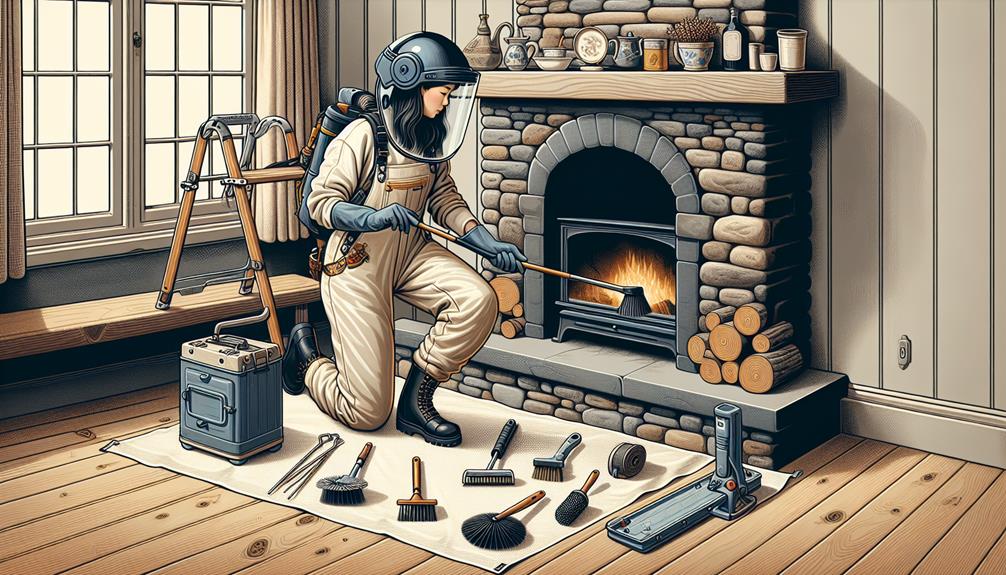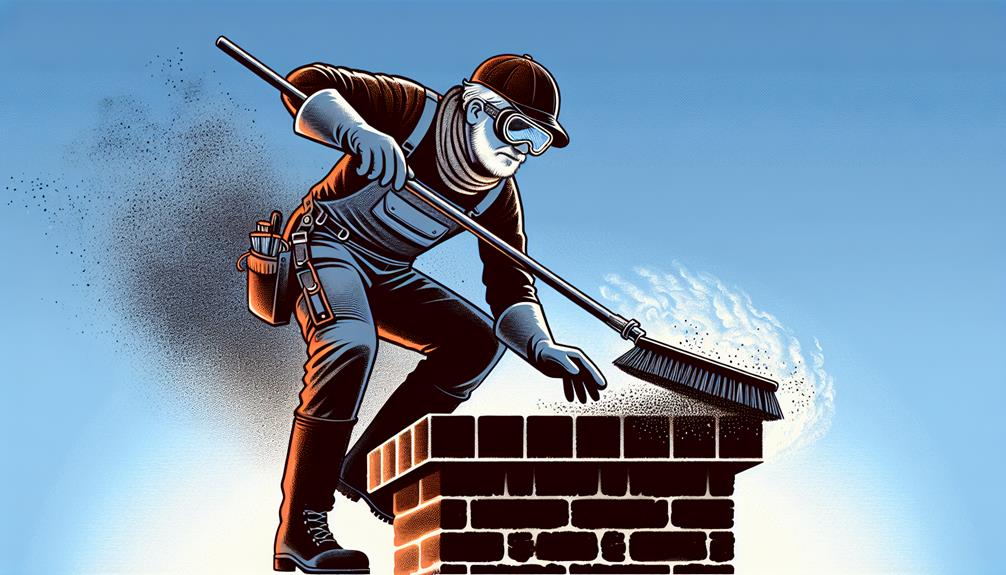To keep your wood stove chimney safe and efficient, you need to clean it regularly. You’ll need the right tools for the job.
Follow these steps to sweep the chimney properly and prevent any dangers.
Let’s dive into the process of maintaining your wood stove chimney in good shape.
Chimney Sweeping Basics
To keep your wood stove safe and working well, regularly clean the chimney with a wire brush. Creosote, a residue from burning wood, can build up in the chimney and start a fire. You can hire a pro or do it yourself to make sure your wood stove stays safe.
Wait for the chimney to cool before cleaning it. Use a wire chimney brush to get rid of creosote buildup, which can be dangerous if left alone. Start from the top and work your way down to remove any dirt and soot. Wear gloves and goggles for protection while cleaning.
Cleaning the chimney not only prevents fires but also helps your wood stove work efficiently. Follow these steps to enjoy a cozy fire without any safety risks.
Required Tools and Equipment
To sweep a wood stove chimney effectively, you need a 6-inch round brush for a 6-foot pipe. Make sure to use a chimney brush that fits your flue liner to remove soot and creosote buildup, which can cause chimney fires.
Chimney sweepers recommend tools like the Sooteater for a thorough clean. Check for 3 screws at each joint to keep your chimney sturdy. Creosote logs can help clean, but use them carefully.
Trim the Sooteater head slightly larger than the pipe’s inner diameter for best results. Having the right tools will help you maintain your chimney and prevent chimney fires.
Inspecting the Chimney Structure
Check the chimney for cracks, damage, or wear that could be dangerous. Look for creosote buildup, nests, or debris that could block airflow. Make sure the chimney cap is secure to prevent water damage and keep animals out.
Inspect the chimney liner for damage to maintain proper ventilation and safety. Ensure the chimney is firmly attached to the roof to avoid accidents. Regular inspections and maintenance will help keep your chimney and wood stove in good condition for efficient use.
Preparing the Chimney for Cleaning
To prepare your chimney for cleaning, start by checking for any visible damage or blockages. Remove the chimney cap and look for creosote buildup with a flashlight. This is important to ensure a smooth cleaning process.
Seal off the fireplace opening to prevent debris from falling into the room. Make sure the damper is open for ventilation and access to the chimney interior. Prioritize safety by using a sturdy ladder and wearing protective gear when sweeping the chimney.
Keeping safety in mind, proceed with the cleaning process once everything is checked and in order. A clean chimney is crucial for the safe and efficient operation of your wood stove, so taking the time to prepare it properly is well worth it.
Sweeping the Chimney Using a Brush
To clean your wood stove chimney:
Use a wire brush that matches the chimney’s size. Attach the brush to rods to reach from the top to the stove, scrubbing off soot and creosote buildup. This helps prevent chimney fires and keeps your stove working well. Make sure the brush fits snugly but moves easily.
Cleaning the entire chimney ensures safety and efficiency. Remember, a clean chimney is a safe chimney!
Cleaning the Chimney From Inside
To keep your wood stove working safely and well, use a wire brush to clean the chimney inside. Gently push the brush into the chimney to remove creosote and soot. This stops chimney fires and helps air flow correctly. Check for any cracks or damage while cleaning to fix them before they become dangerous.
For a thorough clean, use long-handled wire brushes to clean the smoke pipes connected to the chimney. This step is crucial to keep air moving and prevent blockages. After cleaning, use a vacuum cleaner to remove any fallen soot and creosote from the bottom of the chimney. This keeps your wood stove running smoothly and safely.
Remember to tidy up the area after cleaning to avoid any debris affecting the stove’s performance. Regularly inspecting and cleaning your chimney is key to a safe and efficient wood stove operation.
Final Inspections and Safety Checks
After cleaning the chimney, use a flashlight to check for any leftover creosote or debris. Make sure there are no damages or blockages that could stop proper airflow. Remove all tools from the chimney before using it to stay safe.
Check that the chimney is clear and safe, and ensure the chimney cap and damper are in good shape before lighting a fire. By doing these checks, you can have a cozy fire in your wood stove without worrying about any problems.
Keep safe and warm by making sure your chimney is ready for each use.
Frequently Asked Questions
How do I clean a chimney for a wood-burning stove?
To clean a chimney for a wood-burning stove, use a wire chimney brush to remove creosote buildup. Consider hiring a professional for a thorough inspection. This helps prevent chimney fires and ensures safe operation.
How Often Should a Chimney Sweep a Wood Stove?
To keep your wood stove safe, make sure to sweep the chimney once a year. The frequency of cleaning may depend on the type of wood you use and how efficient your stove is. If you’re a new owner, you might need more cleanings at first. If you’re burning poorly seasoned wood, it’s important to clean the chimney every 2–3 weeks to stay safe.
Can I Sweep My Own Log Burner Chimney?
You can clean your log burner chimney yourself with the right tools and by following safety rules. Doing this regularly helps prevent fires and keeps your log burner working well. If you’re unsure about how to do it, it’s best to get help from a professional.
How Can I Sweep My Chimney Myself?
To clean your chimney on your own, use a wire brush, seal off openings, and check for any damage. Remember to start at the top and work your way down for an easier and cleaner job.
Conclusion
In simple terms, cleaning your wood stove chimney is super important to prevent fires and make sure the air flows properly in your home.
By checking, cleaning, and taking care of your chimney regularly, you can have a safe and efficient wood stove.
So, get your tools ready, gear up, and keep your chimney clean to stay cozy and safe all winter long.
Happy sweeping!











